
Henrieta Moravčíková : Fridrich Weinwurm and his contribution to engaged thinking about architecture
One of the frequently discussed topics in the current architectural discourse is the role of the architect in society. However, when we look into the history of architecture, we find parallels of such behavior from the Renaissance utopists, through the utopian socialists of the 19th century, to the representatives of the socialist avant-garde in the first half of the 20th century. It seems that the effort to immediately reflect on the social situation and to change it for the better through architecture regularly appears. The strategies that architects developed in the past changed in relation to the spirit of the times and its crisis manifestations. While in the first half of the 20th century, the planned social changes were related to the elimination of the problems of the industrial city and the housing of workers, later, the driving force became, above all, issues of transportation and energy, or generally ecological problems.
Although the Slovak environment cannot be considered a melting pot of social and architectural discussions, it nevertheless shows that Bratislava was in the first half of the 20th century a place where engaged architecture could manifest itself not only in the form of discussions, texts, or designs but also in the form of architectural realizations. The architect Fridrich Weinwurm played a crucial role in this process. The realization of the residential complexes Unitas and Nová doba was accompanied by an explicitly formulated idea of architecture and construction as direct tools for realizing a change in social order, thus placing it among the groundbreaking contexts of thinking about social housing in Slovakia and in broader regional contexts. Unitas and Nová doba can be simultaneously considered the first consistent contribution of the Slovak architectural scene to the key theme of the European avant-garde at the turn of the 1920s and 1930s.
In the context of the current search for new roles of architects, it is therefore useful to know the course, manifestations, and consequences of the engagement of architects in favor of social change in the past. This will help us not only to deepen our understanding of the architectural profession but also to more objectively evaluate architectural works that can be considered material manifestations of this phenomenon. At the same time, it may facilitate the position of those who would attempt to present similar visions in today’s relativizing times.
Doc. Dr. Ing. arch. Henrieta Moravčíková, research worker and head of the Department of Architecture at the Institute of Construction and Architecture of the Slovak Academy of Sciences; vice-dean for science, research, and doctoral studies at the Faculty of Architecture of STU. She focuses on the theory, history, and critique of 20th and 21st-century architecture. Since 2000, she has served as the chairperson of the Slovak working group of DOCOMOMO – an international organization for the research and protection of modern architecture. She has prepared several domestic and foreign architectural exhibitions. She is the co-author (with M. Dull) of the extensive book publication "Architecture of Slovakia in the 20th Century" (Slovart 2002) and the compiler of the first comprehensive monograph on Slovak architecture "Architecture in Slovakia: A Brief History" (Slovart 2005). She is a recipient of the Literary Fund Award and the Martin Kusý Award for theoretical work in the field of architecture.
The lecture will take place on Monday, May 26, 2014, at 5 p.m. in the technical floor of Villa Tugendhat (the tour of the villa is not part of the lecture).
Admission is 100 CZK; students and seniors 50 CZK
More information >
Although the Slovak environment cannot be considered a melting pot of social and architectural discussions, it nevertheless shows that Bratislava was in the first half of the 20th century a place where engaged architecture could manifest itself not only in the form of discussions, texts, or designs but also in the form of architectural realizations. The architect Fridrich Weinwurm played a crucial role in this process. The realization of the residential complexes Unitas and Nová doba was accompanied by an explicitly formulated idea of architecture and construction as direct tools for realizing a change in social order, thus placing it among the groundbreaking contexts of thinking about social housing in Slovakia and in broader regional contexts. Unitas and Nová doba can be simultaneously considered the first consistent contribution of the Slovak architectural scene to the key theme of the European avant-garde at the turn of the 1920s and 1930s.
In the context of the current search for new roles of architects, it is therefore useful to know the course, manifestations, and consequences of the engagement of architects in favor of social change in the past. This will help us not only to deepen our understanding of the architectural profession but also to more objectively evaluate architectural works that can be considered material manifestations of this phenomenon. At the same time, it may facilitate the position of those who would attempt to present similar visions in today’s relativizing times.
Doc. Dr. Ing. arch. Henrieta Moravčíková, research worker and head of the Department of Architecture at the Institute of Construction and Architecture of the Slovak Academy of Sciences; vice-dean for science, research, and doctoral studies at the Faculty of Architecture of STU. She focuses on the theory, history, and critique of 20th and 21st-century architecture. Since 2000, she has served as the chairperson of the Slovak working group of DOCOMOMO – an international organization for the research and protection of modern architecture. She has prepared several domestic and foreign architectural exhibitions. She is the co-author (with M. Dull) of the extensive book publication "Architecture of Slovakia in the 20th Century" (Slovart 2002) and the compiler of the first comprehensive monograph on Slovak architecture "Architecture in Slovakia: A Brief History" (Slovart 2005). She is a recipient of the Literary Fund Award and the Martin Kusý Award for theoretical work in the field of architecture.
The lecture will take place on Monday, May 26, 2014, at 5 p.m. in the technical floor of Villa Tugendhat (the tour of the villa is not part of the lecture).
Admission is 100 CZK; students and seniors 50 CZK
More information >
The English translation is powered by AI tool. Switch to Czech to view the original text source.
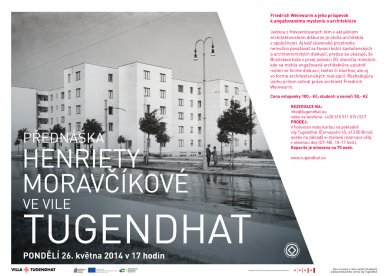
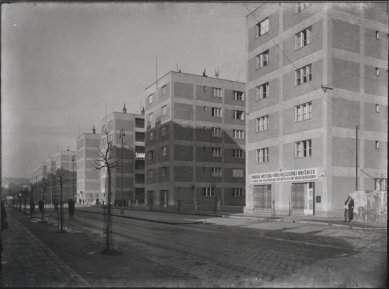
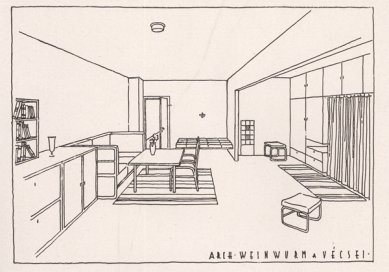
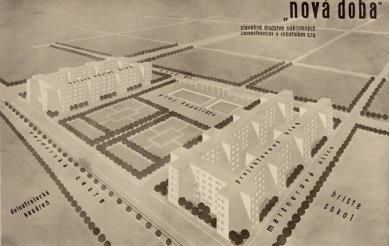
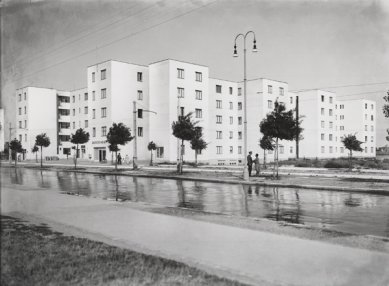
Related articles
1
28.08.2019 | In Brno, they present the architect who gave Bratislava a modern face
0
17.05.2018 | Architect Friedrich Weinwurm: New Path - Final Program
0
27.01.2018 | Architect Friedrich Weinwurm: New Path - Exhibition at SNG
0
12.12.2014 | Printed Architecture: Henrieta Moravčíková
3
26.11.2014 | Jan Tabor in the Tugendhat Villa: A Treatise on the Uniqueness of Relationships
0
03.11.2014 | Anja Krämer : Weissenhof Estate in Stuttgart
0
11.10.2014 | Iris Meder: Viennese Modernism and Its Relation to Czech Modern Architecture











